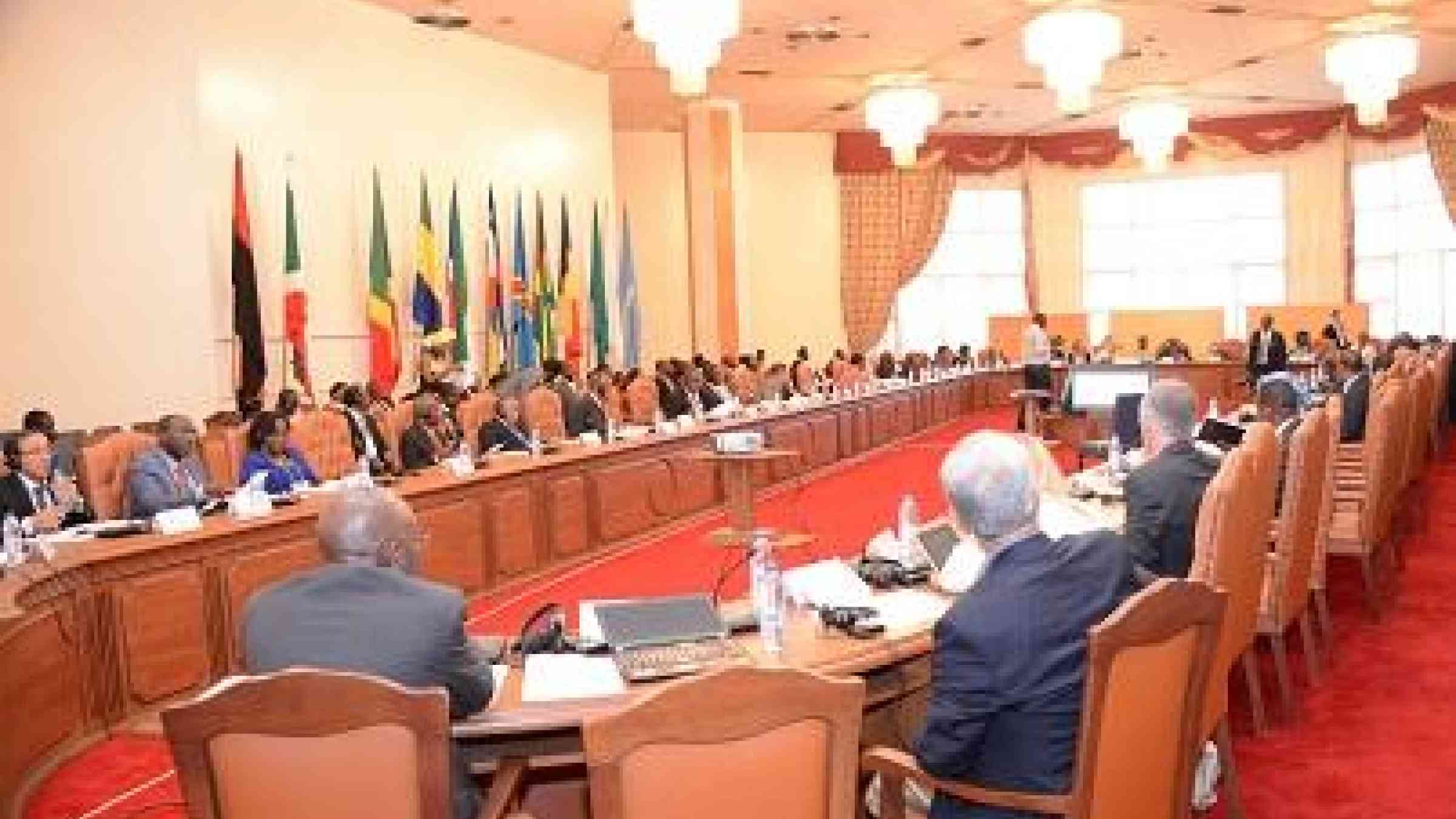Africa backs disaster risk plan

Delegates at the 4th High Level Meeting on Disaster Risk Reduction listen to the formal reading of the Yaoundé Declaration (Photo: UNISDR)
YAOUNDE, 23 JULY 2015 – African governments today vowed to work together curb disaster losses over the next 15 years, with reductions in mortality, the numbers of people affected and the economic damage inflicted by natural and human-induced hazards.
The 37 countries at the 4th High Level Meeting on Disaster Risk Reduction issued the Yaoundé Declaration requesting the African Union to lead on aligning the continent’s strategy with the global targets set down in a new international agreement, the Sendai Framework.
“We have an opportunity now to take ownership of the Sendai Framework and put in place a mechanism for implementing it,” said Mr. Amadou Ali, Vice-Prime Minister of host nation Cameroon.
The Yaoundé meeting is the first intergovernmental session on implementing the 2015-2030 agreement since its adoption in March by the World Conference on Disaster Risk Reduction in Sendai, Japan. That adds momentum to the global implementation drive, which continues with regional meetings elsewhere over coming months.
“This first post-Sendai meeting lays the foundations for a new vision in disaster risk reduction,” said Ms. Marie Chantal Mfoula, Representative of the Secretary General of the Economic Community of Central African States.
“This is all about harnessing our actions to the Sendai Framework,” said Ms. Mfoula, whose 10-nation grouping includes Cameroon.
The Sendai Framework has four priorities: improving risk governance, understanding disaster risk, investing in resilience and enhancing preparedness for effective response, recovery, rehabilitation and reconstruction.
Its impact will hinge on meeting seven global targets, including substantial reductions in disaster mortality, numbers of people affected, economic losses and damage to critical infrastructure.
It was the first in a series of interlocking agreements that will set the tone of global development policy for years -- others include last week’s Addis Ababa Action Agenda on financing for development, September’s Sustainable Development Goals, and a new deal on curbing climate change, in December.
“Africa is setting the pace for the post-2015 Development Agenda through its clear statement of high-level commitment here today to achieving substantial reductions in disaster losses,” said Ms. Margareta Wahlström, head of the UN Office for Disaster Risk Reduction.
“The Sendai Framework calls for a change in emphasis from managing disasters to managing disaster risk, which is critical in a region where floods and storms are the main cause of recurring damage to schools, hospitals and other health facilities,” she added.
Data from the last two decades show that in terms of absolute numbers affected by disasters, Africa has two countries in an otherwise-Asian top ten: Kenya and Ethiopia. Standardizing the figures per 100,000 of population makes the picture even starker: Eritrea, Lesotho, Zimbabwe, Somalia, Kenya and Niger all figure in the top ten.
Direct economic losses from disasters so far this century are estimated at US$2.5 trillion globally. Losses in 40 low- and middle-income countries amounted to US$305 billion over the last 30 years. In Africa alone, from 1990 to 2012, an average of 152 disasters were recorded per year, the majority triggered by hydro-meteorological hazards such as floods and storms. In 2014, over 6.8 million Africans were affected directly by a total of 114 recorded disasters.
Natural and man-made hazards mesh together to claim lives, ruin livelihoods and undermine development. Integrating risk reduction into all areas of policy and planning is therefore central for sustainable development. Targeted action is needed to deal with underlying risk drivers such as poverty, disease climate change, unplanned urbanization, population growth, poor land management, decimation of ecosystems, and weak governance and policies.
“It’s no exaggeration to say that Africa is confronted by a huge range of human-induced and natural hazards,” said Olushola Olayide, head of the African Union’s Division of Environment, Climate Change, Water and Land Management. “So we need to gather political commitments for the effective implementation of the Sendai Framework in Africa.”
The governments endorsed a series of targets drawn up over the previous two days in Yaoundé by experts at the 7th Africa Working Group Meeting on Disaster Risk Reduction. Among them are creating a mechanism to share best practices by 2016, having risk-sensitive investment plans by 2017, and, by 2018, establishing strengthened early warning systems, a disaster risk trust fund, and standardized methodology, guidelines, procedures and tools for risk assessment and analysis.
Besides asking the African Union to lead and coordinate the process, the Yaoundé Declaration also urges member states and Africa’s regional communities to align their own strategies with the Sendai Framework, and asks ministers of planning, economy and finance to fold disaster risk reduction into their policies.
Finally, it calls on Africa’s development partners to prioritize support for implementing disaster risk reduction strategies. Last week, the European Union announced an 80-million-euro, five-year package to boost risk reduction in Africa.
Explore further
Also featured on
Is this page useful?
Yes No Report an issue on this pageThank you. If you have 2 minutes, we would benefit from additional feedback (link opens in a new window).